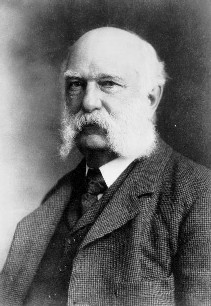James Crafts facts for kids
Quick facts for kids
James Crafts
|
|
|---|---|
 |
|
| 4th President of the Massachusetts Institute of Technology | |
| In office 1897–1900 |
|
| Preceded by | Francis Amasa Walker |
| Succeeded by | Henry Smith Pritchett |
| Personal details | |
| Born | March 8, 1839 Boston, Massachusetts |
| Died | June 20, 1917 (aged 78) Ridgefield, Connecticut |
| Signature | |
James Mason Crafts (born March 8, 1839 – died June 20, 1917) was an American chemist. He is best known for creating the Friedel–Crafts reactions. He developed these important chemical methods with his friend and fellow chemist Charles Friedel in 1876.
Contents
His Life and Education
James Crafts was born in Boston, Massachusetts. His father was Royal Altamont Crafts, and his mother was Marianne Mason. Her father was Senator Jeremiah Mason.
Early Studies in Chemistry
James graduated from Harvard University in 1858. Even though he never earned a special advanced degree called a Ph.D., he studied chemistry a lot. He went to the Academy of Mines in Germany in 1859.
He also worked as an assistant to famous chemists. He helped Robert Bunsen in Heidelberg. Later, he worked with Wurtz in Paris in 1861.
Meeting Charles Friedel
It was in Paris that James Crafts first met Charles Friedel. They would later do some of their most important research together. Crafts came back to the United States in 1865.
In 1868, he became the first professor of chemistry at the new Cornell University. This university is in Ithaca, New York. He taught there until 1870.
Working at MIT and Research in Paris
For the next four years, Crafts was a chemistry professor at the Massachusetts Institute of Technology (MIT). In 1874, he took time off from MIT. He joined Friedel again in Paris. During this time, he focused only on scientific research.
He returned to the United States in 1891. Crafts then became a professor of organic chemistry at MIT from 1892 to 1897. He also served as the president of MIT from 1898 to 1900. In 1900, Crafts left the presidency. He went back to studying problems in organic and physical chemistry.
Important Chemistry Discoveries
James Crafts's work was mostly in organic chemistry. This is the study of carbon-based compounds. But he also made interesting discoveries in physics and physical chemistry.
New Inventions and Measurements
He invented a new type of hydrogen thermometer. He also measured how dense iodine was at very hot temperatures. Crafts showed how the boiling points of similar substances changed with outside pressure.
He also made new compounds of the element silicon. These are interesting because they are like carbon compounds. He also created new compounds using arsenic.
The Friedel-Crafts Reaction
His most important discovery was made with Charles Friedel. They found a very useful way to make new chemicals. This method is called the Friedel–Crafts reaction.
This method has helped create hundreds of new carbon compounds. It works because of the special action of aluminum chloride. This chemical acts as a catalyst, which helps chemical reactions happen faster.
Awards and Honors
Many people recognized James Crafts for his important work in science.
International Recognition
The French government made him a chevalier of the Legion of Honor in 1885. This is a very high award in France. The British Association for the Advancement of Science also made him a special member.
University Honors
Harvard University gave him an honorary degree in 1898. This degree was called a LL.D.. It showed how much they respected his achievements.
The Crafts entry at MIT's Senior House dormitory is named after him.
Selected Writings
- A list of Crafts's papers can be found in the biographical note by Cross.
- Qualitative Analysis (1869, and several later editions)
See also
 In Spanish: James Crafts para niños
In Spanish: James Crafts para niños

